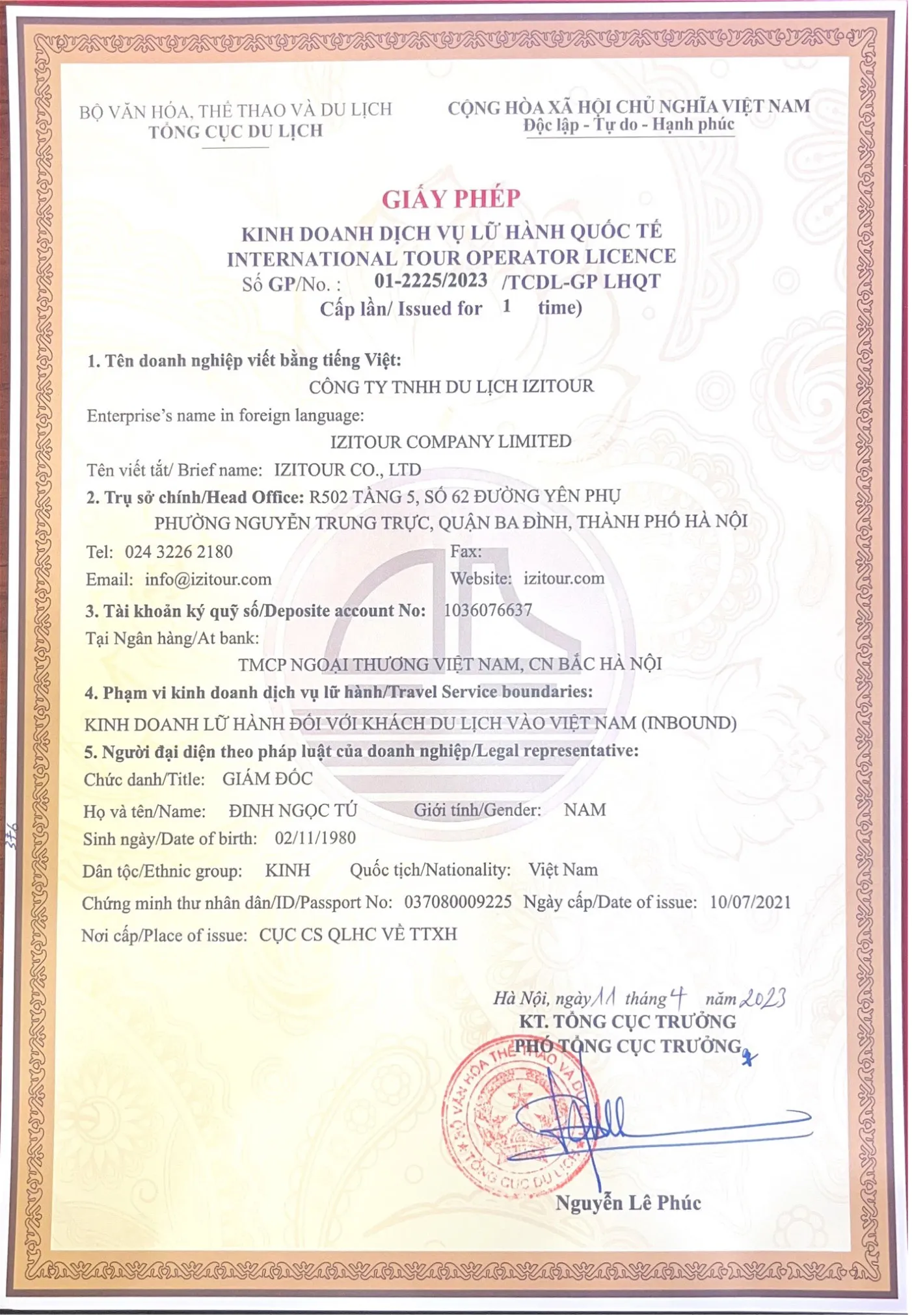In Vietnam, there's a saying: 'Buy a buffalo, get married, build a house.' These three things are seen as the big milestones in a man's life. Among them, marriage holds a very special place. It's not just about love – it's about family, tradition, and community. Vietnamese wedding customs are rich, colorful, and full of meaning, reflecting the deep cultural roots of the country.
1. The role of marriage in Vietnamese culture
Marriage: A reflection of a community-based Culture
While Western societies value individual choice based on love and autonomy, many Asian countries, including Vietnam, which inherited the culture of irrigated rice farming, integrates every personal matter into a community-oriented logic. Marriage does not only concern two individuals but also two families, two lineages—even two villages. It is a strong social act, rooted in the idea of collective harmony and family continuity.
In Vietnam, a wedding is rarely a private event. If you pass by a house decorated in red and white with a tent set up in the middle of the street, chances are it's a wedding! Don't hesitate to approach: the Vietnamese are joyfully hospitable and readily welcome guests, even those just passing by. The more, the merrier! But don't forget: it is customary to bring a small envelope containing money, as a sign of well wishes for the newlyweds and a symbolic contribution to the costs.

An alliance between generations and filial duties
In the Vietnamese tradition, marriage is also a duty towards elders and ancestors. It represents the entry into adulthood, with its responsibilities: maintaining family ties, perpetuating the lineage, and honoring transmitted moral values. The ceremony is not just a party: it is filled with symbolic rituals that express respect for past generations, while committing the young couple to build a future together based on loyalty, filial piety, and shared prosperity.
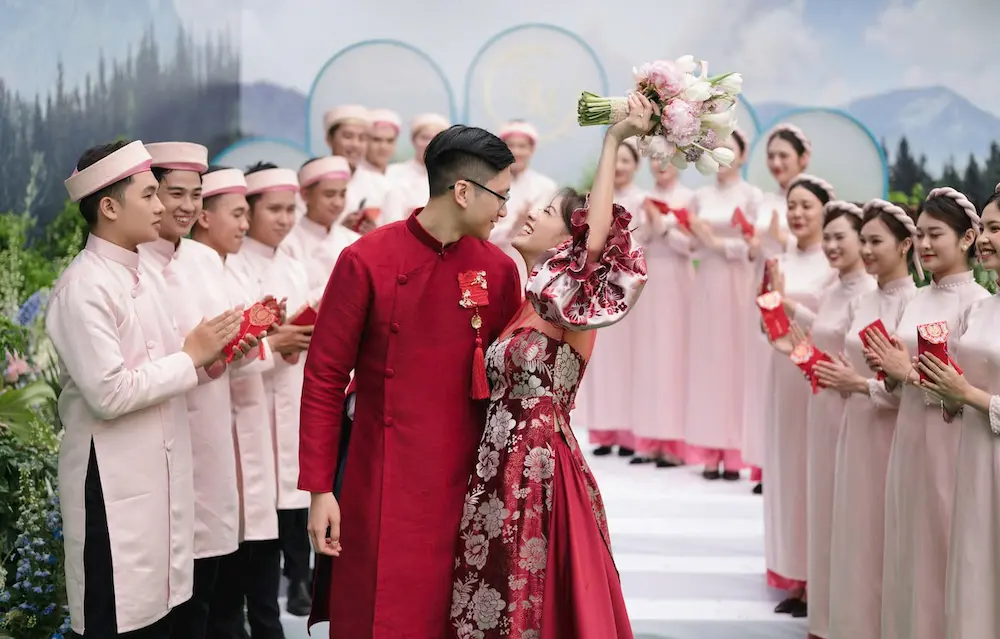
2. Vietnamese wedding traditions
In Vietnam, although the main stages of a wedding are similar throughout the country, each region—North, Central, and South—has its own cultural specificities, expressed through rituals, attire, organization, and family relations. These differences reflect not only historical and geographical influences but also the vision of the couple, the family, and respect for traditions.
2.1. Key steps of a traditional wedding
A traditional wedding in Vietnam generally follows three main ceremonial stages: the preliminary visit (lễ dạm ngõ), the engagement ceremony (lễ ăn hỏi), and the wedding ceremony (lễ cưới). Although these steps are common throughout the country, their execution varies from one region to another.
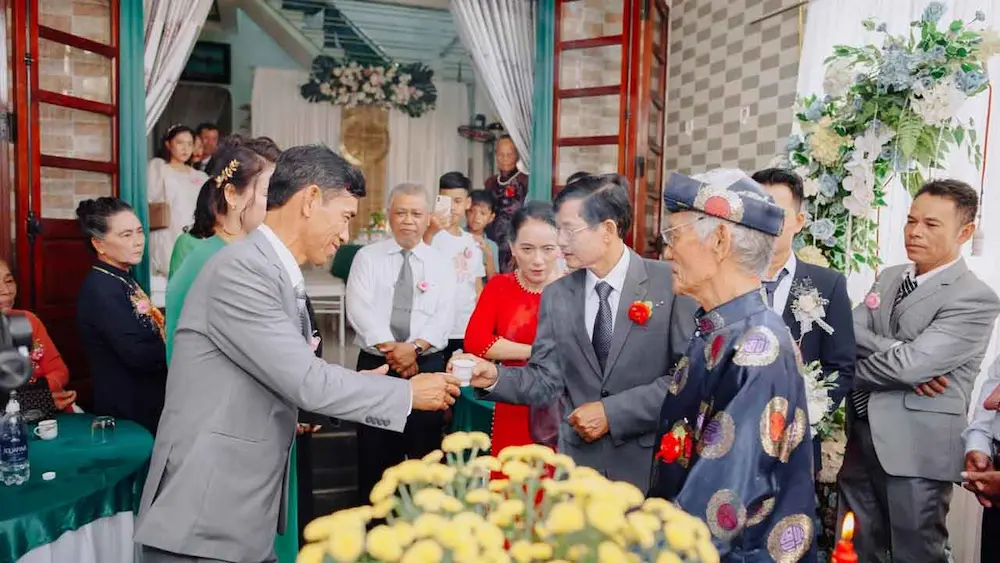
2.2. Important symbols and rituals
In a traditional Vietnamese wedding, each offering presented by the groom's family to the bride's is much more than a simple gift. Generally, these presents are organized into ritual trays, always in an odd number (5, 7, or 9) to bring luck and fertility. Here are the most emblematic trays:
Areca Nuts and Betel Leaves
An emblematic symbol of the Vietnamese wedding, the areca nuts and betel tray is always presented first in engagement ceremonies. It represents the sacred and indissoluble union between man and woman. The areca nut embodies the husband, the betel leaf the wife, while the natural bond between the two symbolizes lasting, faithful, and respectful love.
This symbol has its roots in a popular Vietnamese legend, that of two brothers in love with the same woman, whose fidelity and loyalty touched the heavens, transforming them into a stone, a betel plant, and an areca tree—three inseparable elements. Hence the Vietnamese proverb: A quid of betel is the beginning of all conversation), highlighting the fundamental role of this emblem in any marital agreement.
The nuts are sometimes finely carved or folded into artistic shapes, always arranged in even numbers—a pledge of harmony and prosperity. By offering areca nuts and betel, the groom's family shows its respect, sincerity, and its wish to seal an honorable union.
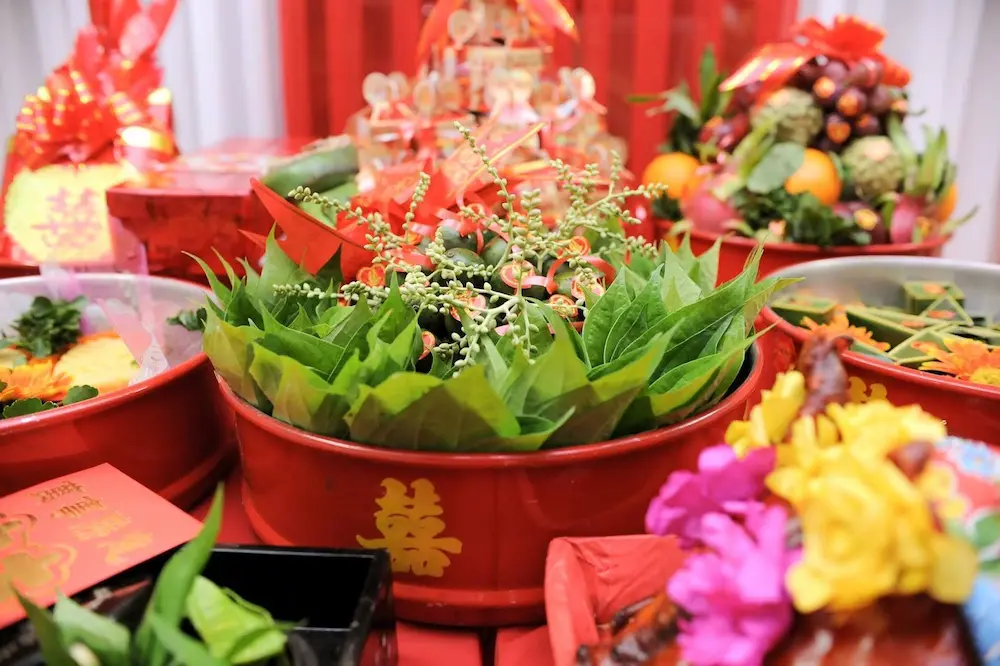
Husband and Wife Cake
The husband and wife cake is an essential traditional cake at engagement and wedding ceremonies in Vietnam. It symbolizes faithful love, tenderness, and harmony of the couple in married life. This cake, with its soft and shiny texture, consists of a translucent dough made from fragrant sticky rice starch and a sweet filling of mung beans, grated coconut, and lotus seeds.
Each ingredient is meaningful: the outer layer that envelops the filling represents protection and union, while the sweet taste and golden color of the cake evoke lasting happiness. This cake also embodies the balance of the five natural elements through its colors: white, yellow, black, green, and red. Presented in pairs, tied with a red ribbon, and often placed in a crimson paper box, this cake is both an offering of respect and a blessing for a harmonious, faithful, and prosperous marital union.

Betrothal Money
The betrothal money, or tiền nạp tài, is a central element of engagement ceremonies in Vietnam. It is not a simple transfer of wealth but an act full of meaning: it represents the gratitude of the groom's family towards the bride's family for having raised, educated, and prepared her to become a wife.
Usually presented in several red envelopes, this money also helps cover part of the festival-related expenses. It demonstrates the future husband's willingness to assume his responsibilities and the solidarity between the two families in the nascent union. In some regions, its amount is symbolic; in others, it may reflect social standing or family expectations. But whatever its value, betrothal money remains above all a message of honor and respect.

Rice Alcohol and Tobacco
This tray is dedicated to paying homage to ancestors and elders. Pure rice alcohol is used in libations on the family altar to invoke the spirits' blessing on the union. As for cigarettes, they are offered to elderly men as a sign of respect, according to a custom deeply rooted in Confucian tradition.
The presence of this tray in the ceremony reflects filial piety, gratitude towards previous generations, and the desire to begin the marriage under the auspices of the ancestors. Every gesture made around this tray follows a codified protocol, filled with respect and solemnity.
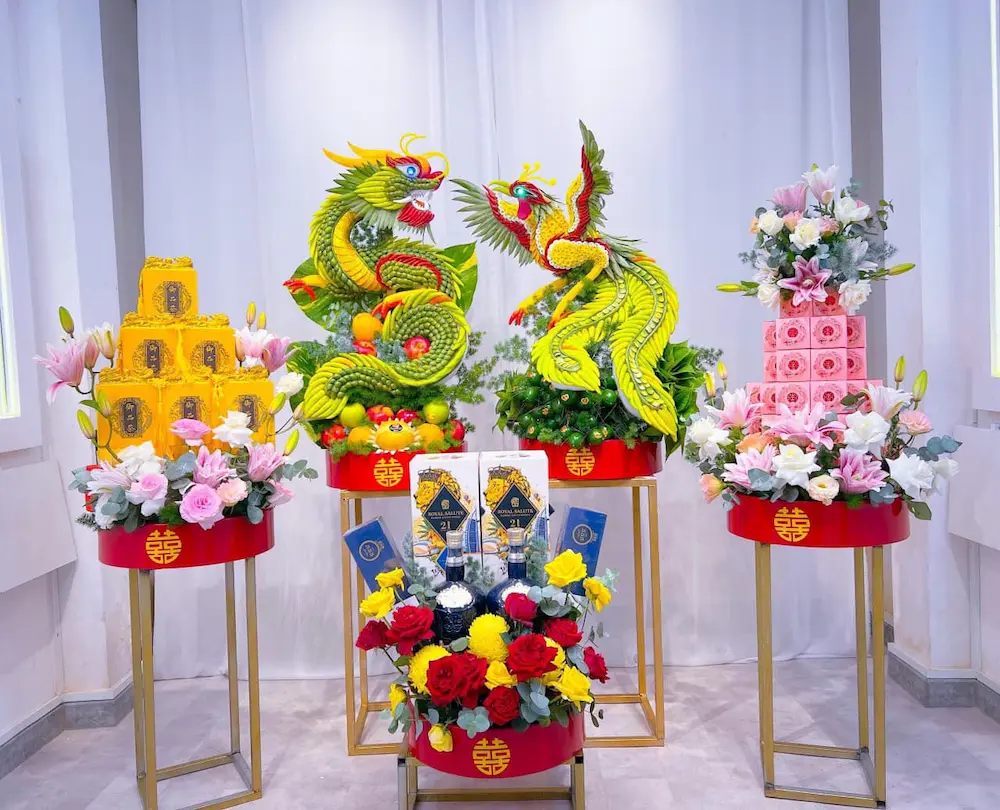
Offering Trays
The five-fruit tray, is an indispensable symbolic offering in traditional Vietnamese weddings, as well as during Tết (Lunar New Year). It is based on an ancient belief that five carefully selected fruits represent the five elements of the cosmos (wood, fire, earth, metal, water) and embody the harmony between man, nature, and spiritual forces.
Each chosen fruit carries a particular meaning, blending material wishes and moral values:
- Banana: Shaped like an open hand, it symbolizes divine protection and a warm welcome. It forms the base of the tray, like the outstretched arms of a family ready to embrace a new life.
- Grapefruit: Round and generous, it embodies prosperity and fertility, expressing the hope of having strong and healthy children.
- Papaya: Its name means "sufficient abundance," representing the wish for a married life without lack, where material and emotional resources are always balanced.
- Mango: Evokes sweetness in speech and conduct. It also symbolizes success in professional life, wishing that the couple builds a flourishing future together.
- Fig: A sacred and fertile fruit, it embodies fullness, joy, and longevity. Present in many spiritual ceremonies, it calls for serenity in the home.
Brought together, these five fruits are not just chosen for their taste or beauty, but for their deep symbolic meaning. They convey the families' wishes for the couple: to live in peace, abundance, health, fidelity, and joy. The five-fruit tray is therefore a silent prayer, expressed by nature, for a blessed and lasting union.
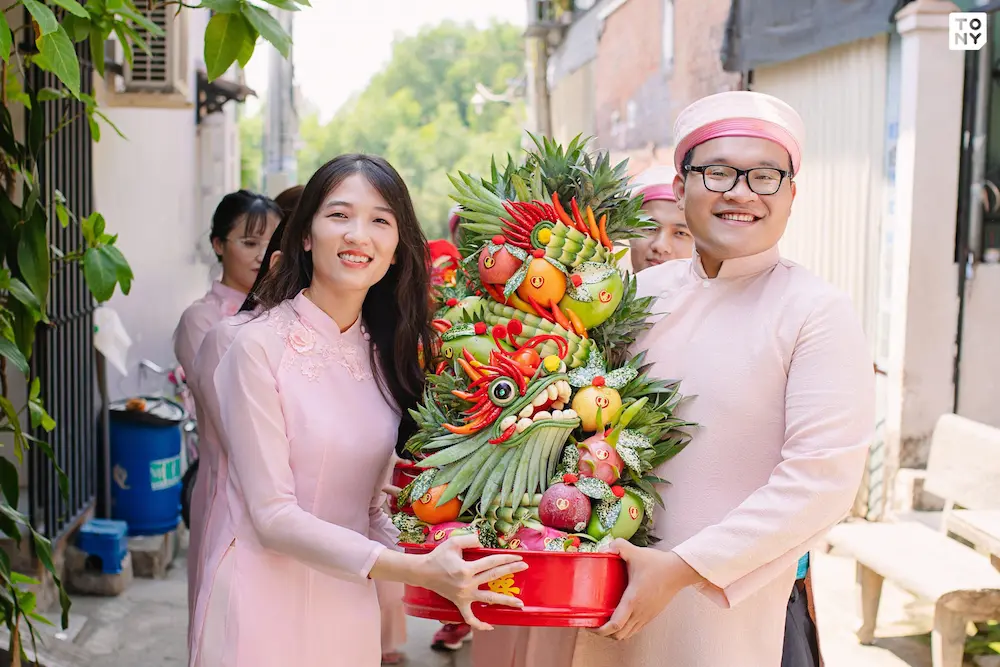
Sticky Rice with Gac Fruit
The red sticky rice holds a special place not only in weddings but also in traditional Vietnamese celebrations. Behind its beautiful red-orange color lies a deep symbolism: in Vietnam, red is the color of happiness, prosperity, and luck—but also of ardent love and marital harmony. The red of the gac fruit, a gift from nature, represents a sacred balance between heaven and earth, between passion and serenity in life together.
The sticky texture of the rice embodies the indissoluble bond between the spouses, while its rich flavors—the softness of the rice, the sweetness of the gac, the creaminess of the mung beans—evoke the tenderness and warmth of the home. This dish is much more than a simple meal: it is an offering of sincere wishes for a fruitful and lasting marriage.
Preparing xôi gấc is a meticulous act filled with goodwill. The cook chooses ripe, round, and heavy gac fruits, whose flesh is mixed with a little rice wine to extract its intense color and fragrance. The sticky rice is carefully washed and soaked overnight. Once mixed, the ingredients are steamed, then seasoned with a hint of sugar and vegetable oil to obtain a shiny and smooth dish.
Served hot on the ritual trays, xôi gấc illuminates the nuptial table with its vibrant hue and its lucky meaning. It is also found during Tết (Lunar New Year), birthdays, and longevity parties, highlighting its importance as a messenger of joy and prosperity. Thus, in Vietnamese culture, every bite of xôi gấc is a silent blessing: may the couple live a sweet, harmonious, and happy union forever.
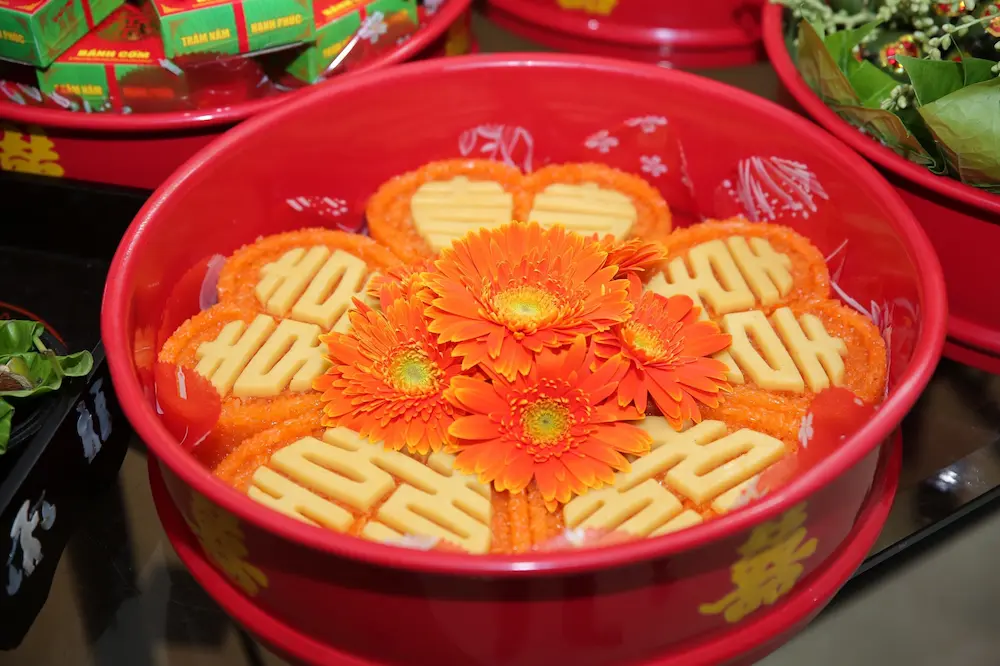
2.3. Marriage yesterday and today
Perception of Marriage: From a Family Duty to a Personal Choice
In traditional Vietnamese society, marriage was not just a matter of feelings, but above all a responsibility towards the family and ancestors. It was about perpetuating the lineage, respecting social alliances, and adhering to the principle of môn đăng hộ đối—a marriage between families of equal status. Unions were often arranged by parents, with little or no consultation with the main parties involved.
Today, this concept has profoundly changed. Love, emotional compatibility, and a shared life plan have become the foundations of modern marriage. Young people freely choose their partners and view marriage as a personal decision, synonymous with mutual fulfillment. However, parental approval remains important, reflecting a subtle balance between individual independence and respect for traditional values.

Rites and Ceremonies: Between Tradition and Modernity
The traditional Vietnamese wedding included many codified and highly symbolic rites: mai mối (matchmaking), chạm ngõ (preliminary visit), lễ ăn hỏi (engagement), lễ nạp tài (offerings),lễ xin dâu and rước dâu (procession), lễ lại mặt (return to the bride's home)... Each step was imbued with respect for ancestors, the community, and the family hierarchy.
Today, couples simplify the ceremonies to better adapt to modern urban life. Only five steps are often retained: lễ dạm ngõ, lễ ăn hỏi, lễ xin dâu, lễ cưới, and lễ lại mặt. Furthermore, celebration venues are evolving: weddings can take place at home or in modern reception centers. The ceremony may mix traditional elements—like the ancestral altar—with Western-inspired practices, such as the exchange of rings or the cutting of the cake.

The Role of Families: From Authority to Guidance
In the past, marriage was more the affair of the two families than of the future spouses. Parents—or even grandparents or uncles—had the final say on the choice of a spouse, the organization of the wedding, and the conditions of the union. The approval of the elders was not only essential but decisive.
Today, the role of families has evolved into more flexible and benevolent guidance. While they remain involved in preparations and blessings, their position is now more advisory than imposing. In modern or mixed-culture couples, this change is even more pronounced. It shows a desire to transmit values without constraint, fostering intergenerational dialogue and the adaptation of traditions to a changing world.
3. Legal requirements for getting married in Vietnam
In Vietnam, marriage is not just a matter of the heart or traditions—it is also strictly regulated by law. Whether you are a Vietnamese couple or a mixed couple, certain formalities must be completed for your union to be officially recognized. Anticipating these steps helps avoid unpleasant surprises and allows you to experience this stage with serenity.
Legal Conditions for Marrying in Vietnam
Before any procedure, certain fundamental conditions must be met, regardless of the spouses' nationality:
- Be of legal age: at least 20 for men and 18 for women;
- Not be married to a third party at the time of registration;
- Not have a family relationship prohibited by law;
- Be mentally capable of understanding and consenting to the marriage;
- The marriage must be entered into freely and voluntarily, without coercion.
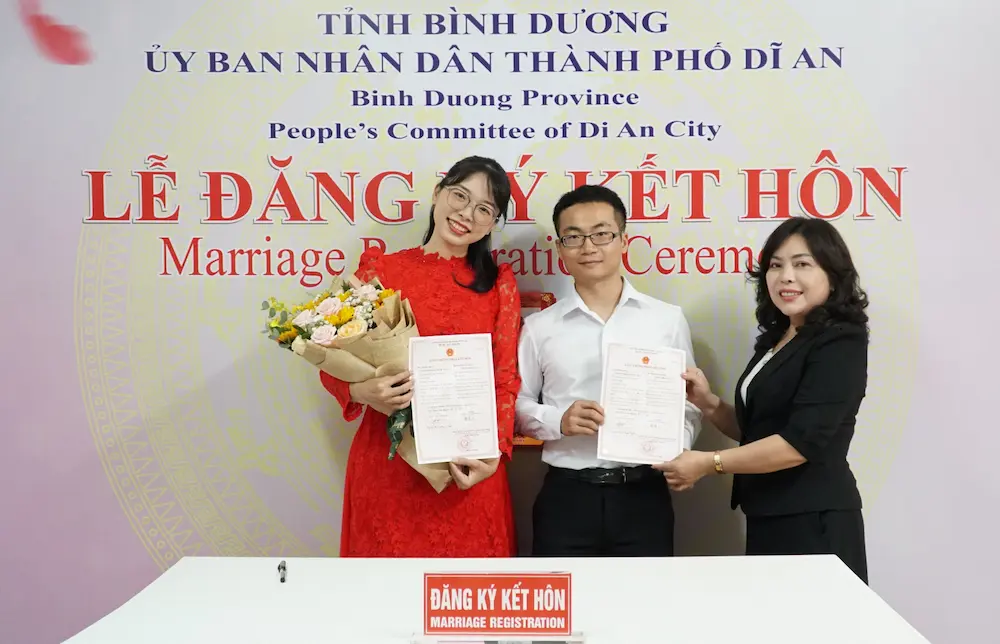
3.1. For Vietnamese couples
For Vietnamese couples, the procedures are relatively simple but require several official documents, to be submitted to the local civil status office:
- National ID card
- Birth certificate
- Certificate of single status or civil status certificate
- Divorce decree or death certificate of the previous spouse, if applicable
After submitting the file, a period for the publication of banns is observed to allow for any objections. Once this period has passed, the union can be celebrated in a civil ceremony at the town hall, where the marriage certificate is signed.
3.2. For mixed or foreign couples
In Vietnam, a marriage between a Vietnamese citizen and a foreigner, or between two foreigners, is permitted under strict conditions, particularly concerning residency and supporting documents.
Marriage between a Vietnamese national and a foreigner
The couple must submit a file to the district-level People's Committee where the Vietnamese person resides.
Necessary Documents:
Vietnamese Side | Foreigner Side |
|---|---|
|
|
After the file is submitted, the authorities conduct a verification and then set an interview date. If everything is in order, the civil marriage can be celebrated and registered.
Marriage between two foreigners in Vietnam
A marriage between two foreign nationals can be registered only if both individuals are legal residents in Vietnam.
Required file:
- Valid passports and visas;
- Certificates of single status/capacity to marry for both parties, issued by their respective embassies;
- Vietnamese translations of foreign documents, legalized or with an apostille;
- Proof of residence in Vietnam
The procedure is similar to that for mixed couples: submission of the file, verification, interview, and then registration of the marriage by the local civil status office.
Please note:
- A tourist visa is not sufficient. Vietnamese authorities require proof of official residence in the country.
- If both individuals are on a short stay, it is advisable to turn to their respective embassy or consulate to learn about the options (consular ceremony, registration in their home country, etc.).
4. The average budget of a Vietnamese wedding
How much does it cost to organize a wedding in Vietnam? The cost of a wedding in Vietnam varies considerably depending on the region, the number of guests, and the style of the ceremony. In rural areas, weddings are often organized at home, with the active participation of the community, which helps limit expenses. In contrast, in urban areas, especially in Hanoi or Ho Chi Minh City, couples increasingly opt for professional services: venue rental, catering, floral decoration, musical entertainment, photography, etc.
- In rural areas, an "average" wedding costs between 150 and 300 million VND ($5,900 - $11,800 USD).
- In urban areas, this figure can reach 300 - 600 million VND (~$11,800 - $23,500 USD), or even more for Western-style weddings.
To these costs are added traditional (or modern) outfits, ritual trays, betrothal money, administrative fees, and sometimes a honeymoon. More and more young couples are combining Vietnamese traditions with contemporary inspirations, creating personalized celebrations that are both respectful of the past and forward-looking.
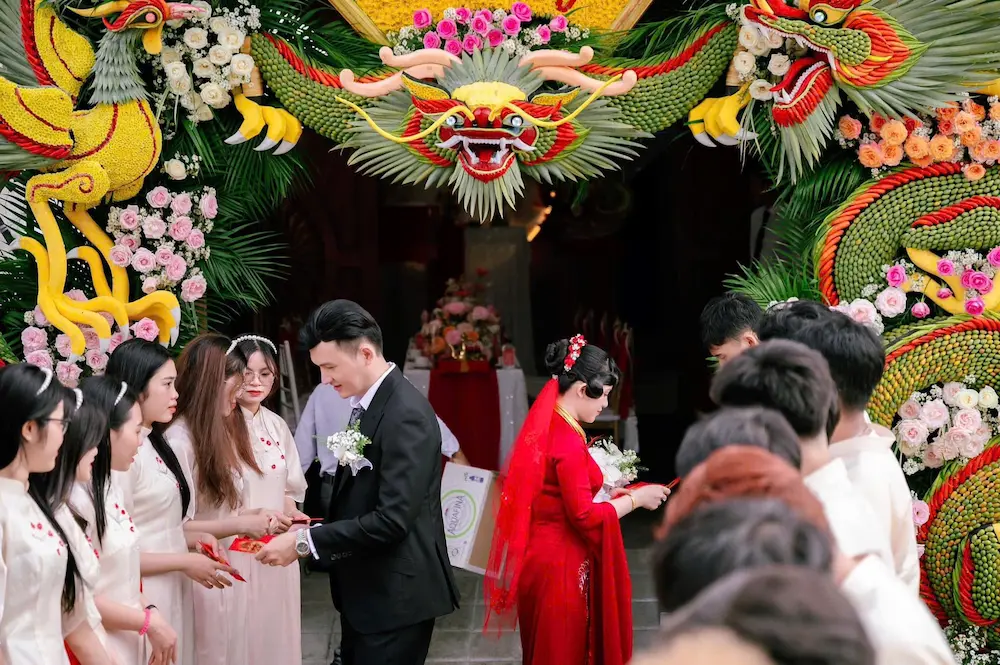
Key considerations for a Vietnamese wedding
- The choice of the wedding day is crucial: it is common to consult a master of ceremonies or an astrologer to determine an "auspicious" date, based on astrological signs, the lunar calendar, and the compatibility between the future spouses. A "good day" is supposed to guarantee a harmonious, prosperous, and lasting marriage.
- The monetary gift is the norm: guests offer an envelope containing money, as a wish for happiness and to help the newlyweds cover the costs. The amount depends on the relationship with the couple and the standard of the ceremony.
- Outfits should be elegant but modest: bright colors are preferred, while black is traditionally avoided. Red is reserved for the bride, as it symbolizes luck and prosperity.
- Community participation remains strong: especially in the countryside, a wedding is also a collective event. Neighbors help prepare the festivities, strengthening social ties and local solidarity.
A wedding in Vietnam is much more than a simple event, it is a celebration of love, family, and traditions rooted in the country's millennial history. Whether you are curious about local customs or planning to get married in the heart of this fascinating country, understanding the rites and symbolism of a Vietnamese wedding allows you to better appreciate the full richness of this culture.
See more:
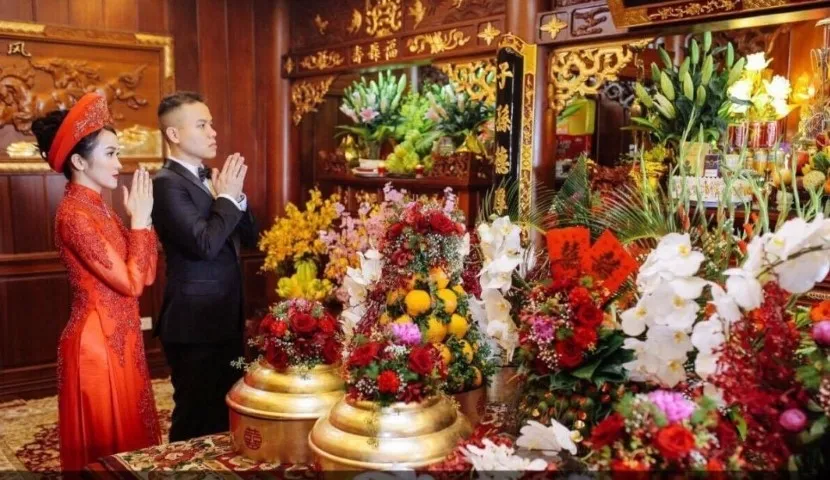







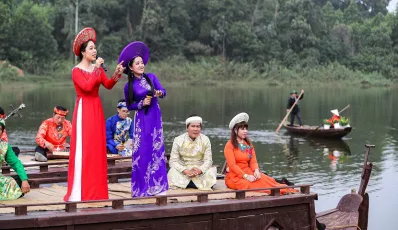
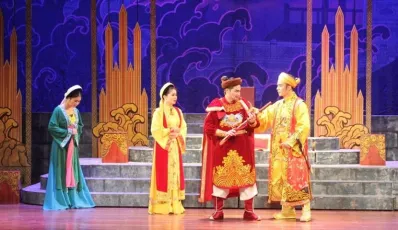
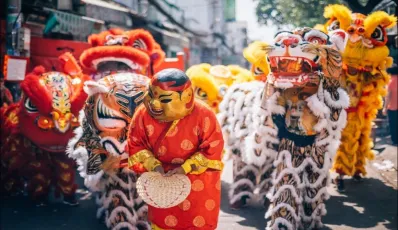

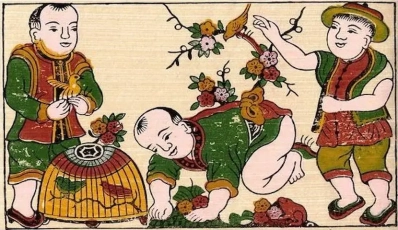

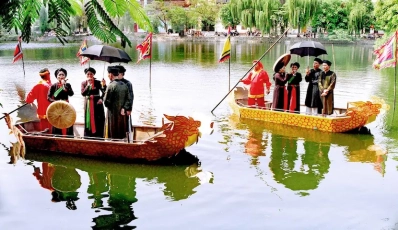



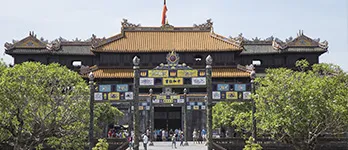


 TRAVELERS' CHOICE 2025
TRAVELERS' CHOICE 2025 